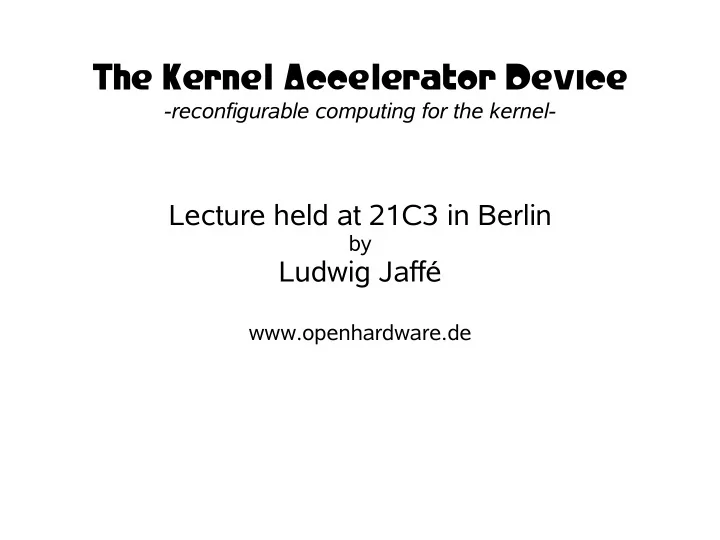

The Kernel Accelerator Device -reconfigurable computing for the kernel- Lecture held at 21C3 in Berlin by Ludwig Jaffé www.openhardware.de
Why do we want the KAD ? ● Many things we like are too slow – drive encryption – cryptoanalysis – DSP-functions for video-transcoding .... ● How to solve computing-intensive problems? – The conventional way: ● throw more mips at the problems - and transform yor computer room into a sauna club - – The smarter way ● use reconfigurable hardware ...
What is the KAD ? ● The KAD is – a reconfigurable computer subsystem . – user-configurable to do computing intensive jobs in hardware – as easy to use as a kernel module in linux – a piece of open source hardware ● The KAD consists of – PCI-Card with FPGAs – compiled vhdl (and/or verilog) code which does certain jobs – special kernel modules to make the KAD useable for the masses
How does it work? 1. The user loads a special kernel module she wants to use. (e.g. loop-AES with KAD-Support) 2. The kernel module sets up communication to KAD via PCI 3. The kernel module configures the KAD to do the dirty job with firmware precompiled from open-source hdl-code. (e.g. it loads an AES-IP-Core with some glue logic into the FPGAs) 4. The kernel module does the dirty job by mostly transfering data between other kernel components and the KAD ( using memory mapped IO this means quite low CPU-load.) 5. The user unloads the special kernel module (the module wipes the keys -if any- inside the FPGAs and erases them)
What does reconfigurable computing? General-purpose vs. reconfigurable computers 1/2 ● General-purpose computers: – program a fixed component (CPU) to do the things. – step in sequence through a set of instructions in the dimension of time: Example: Adding two numbers using a CPU: MOV A,23 ;Load Register A MOV B,42 ;Load Register B ADD A,B ;The sum is in Register A MOV Result,A ;Store the Result If we want to add (a+b and c+d) we need to execute the program twice which means that we need twice the time.
What does reconfigurable computing? General-purpose vs. reconfigurable computers 2/2 ● Reconfigurable computers: – program a programable component (FPGA) to do the things. – compute using configued functional units and interconnects. – compute in parallel specific, configured operations in the dimension of space. Example: Adding two numbers using a FPGA: A sum & B If we want to add (a+b and c+d) the same time we need two adders, which means that we need twice the space .
What is so special about FPGAs? FPGA ● means F ield P rogramable G ate A rray ● consists of – Logic Blocks (the idea is similar but the implementations differ slightly) ● called Logic Elements (LE) by Altera ● called Configurable Logic Blocks (CLB) by Xilinx – programable Routing fabric – universal I/O-Cells – some extras such as PLLs, dedicated RAM, dedicated functions (e.g. Multipliers)
What is so special about FPGAs? Structure of a FPGA
What is so special about FPGAs What does a Logic Element look like?
The Architecture of the KAD <1/4> The System-View load/unload kernel module + application specific stuff Userland Application KAD-Kernel Module configures FPGAs with Firmware + supports FPGA Bus Transport (PCI) 66Mhz, 32Bit PCI, VIO=3.3V / USB2.0? / PCMCIA ? KAD Bridge-FPGA PCI2Wishbone bridge & Reconfiguration Engine user reconfigurable FPGAs do the job: Encryption, DSP-Functions, cryptoanalysis..
The Architecture of the KAD <2/4> The Hardware-View Expansion Ports – pci2wishbone bridge – ● possible Interconnects using wishbone SoC-Bus – plugs and flat cable ● expansion modules reconfiguration of SRAM-based – FPGAs HW-Random, SRAM etc. KAD www.openhardware.de Expansion Expansion Expansion interconnect interconnect USER- USER- USER- Fixed FPGA FPGA FPGA FPGA #3 #2 PCI2Wishbone #1 Reconfi- Bridge guration FPGA Wishbone Bus PCI 32Bit/66Mhz cut for low- cost versions
The Architecture of the KAD <3/4> ● The Operating System -View – Userland interface ● depends on intended application – KAD-Kernel modules ● include pre-compiled VHDL as firmware ● have firmware loader to configure the FPGAs ● support their firmware inside the FPGAs ● initiate and coordinate data transfers (memory mapped IO via PCI) ● interface to other kernel modules and/or userland
The Architecture of the KAD <4/4> ● The VHDL-View – Use of IP-Cores ● provides fast time to “market” and lowers risks ● open-source IP-cores are combined to form a system ● additional vhdl-code does the needed interfacing and some special stuff like reconfiguration – How to compile, fit and simulate? ● We use no-cost tools by the FPGA vendors (Altera vs. Xilinx) – VHDL-Versions are treated as part of the kernel- modules to prevent chaos and frustration
Open Source Hardware ● Design Reusability ● Resources about Open Source Hardware – www.opencores.org (IP-Cores) – www.openhardware.de (KAD-Project) – www.opencollector.org (Info about open source HW) ● EDA-Tools – GNUeda vs. free closed source eda
How can I participate? ● The KAD-Project needs – Architects to define the datailed KAD concept (20% done) – Hardware Designers (5% done) – VHDL-coders and integrators (0% done) – Kernel module coders (0% done) – Ideas for new applications (never done)
Recommend
More recommend